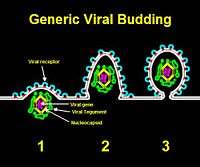Viral shedding
 |
Viral shedding refers to the expulsion and release of virus progeny following successful reproduction during a host-cell infection. Once replication has been completed and the host cell is exhausted of all resources in making viral progeny, the viruses may begin to leave the cell by several methods.[1]
The term is used to refer to shedding from a single cell, shedding from one part of the body into another part of the body,[2] and shedding from bodies into the environment where the viruses may infect other bodies.[3]
Via budding

"Budding" through the cell envelope—in effect, borrowing from the cell membrane to create the virus's own viral envelope—is most effective for viruses that need an envelope in the first place. These include enveloped viruses such as HIV, HSV, SARS or smallpox. Prior to budding, the virus may put its own receptor onto the surface of the cell in preparation for the virus to bud through, forming an envelope with the viral receptors already on it. Though budding does not immediately destroy the host cell, this process will slowly use up the cell membrane and eventually lead to the cell's demise. This is also how antiviral responses are able to detect virus-infected cells.[4]
Via apoptosis
Animal cells are programmed to self-destruct when they are under viral attack or damaged in some other way. By forcing the cell to undergo apoptosis or cell suicide, release of progeny into the extracellular space is possible. However, apoptosis does not necessarily result in the cell simply popping open and spilling its contents into the extracellular space. Rather, apoptosis is usually controlled and results in the cell's genome being chopped up, before apoptotic bodies of dead cell material clump off the cell to be absorbed by macrophages. This is a good way for a virus to get into macrophages either to infect them or simply travel to other tissues in the body.
Although this process is primarily used by non-enveloped viruses, enveloped viruses may also use this. HIV is an example of an enveloped virus that exploits this process for the infection of macrophages.[5]
Via exocytosis
Viruses also leave cells through exocytosis, in which the host cell is not destroyed. Viral progeny are synthesized within the cell and the host cell's transport system is used to enclose them in vesicles; the vesicles of virus progeny are carried to the cell membrane and then released into the extracellular space. This is used primarily by non-enveloped viruses, although enveloped viruses display this too. An example is the use of recycling viral particle receptors in the enveloped varicella-zoster virus.[6]
References
- ↑ N.J. Dimmock et al. "Introduction to Modern Virology, 6th edition." Blackwell Publishing, 2007.
- ↑ Massachusetts Department of Public Health - Rabies Control Plan - CHAPTER 1: GENERAL INFORMATION - "Definitions as Used in this Document [...] Shedding - The release of rabies virus from the salivary glands into the saliva."
- ↑ J Infect Dis. 1979 Oct;140(4):610-3 article Viral shedding patterns of children with influenza B infection
- ↑ Owen Pornillos, Jennifer E. Garrus and Wesley I. Sundquist. "Mechanisms of enveloped RNA virus budding." Trends in Cell Biology, Volume 12, Issue 12, 1 December 2002, Pages 569-579
- ↑ Sheila A. Stewart, Betty Poon, Joo Y. Song, and Irvin S. Y. Chen. "Human Immunodeficiency Virus Type 1 Vpr Induces Apoptosis through Caspase Activation." Journal of Virology, April 2000, p. 3105-3111, Vol. 74, No. 7
- ↑ J K Olson and C Grose. "Endocytosis and recycling of varicella-zoster virus Fc receptor glycoprotein gE: internalization mediated by a YXXL motif in the cytoplasmic tail." J Virol. 1997 May; 71(5): 4042–4054.
| ||||||||||||||||||||||